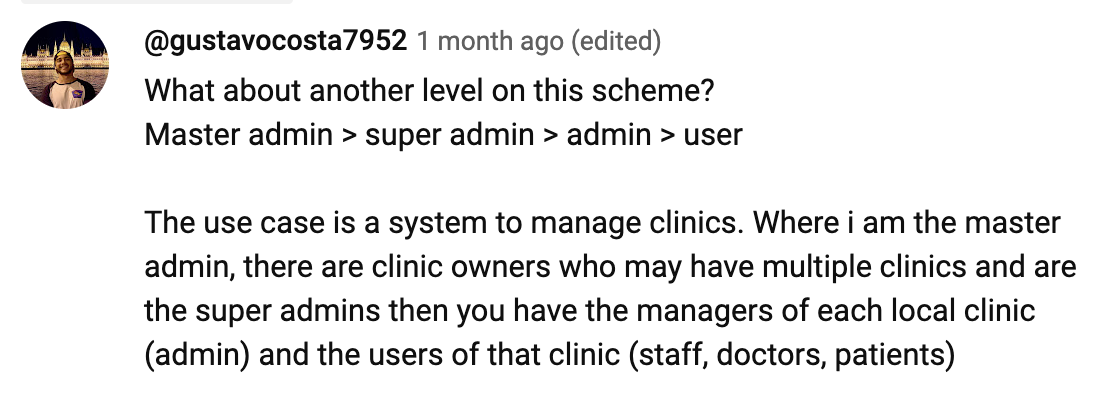In this course section, let's get to a more complex example with Teams and Roles.
Scenario
Imagine a scenario for managing clinics. The application has roles in a hierarchy: master admin > super admin > admin > user.
The idea comes from a real comment on our YouTube channel:

We've tried to re-create that scenario in this demo project:
-
master adminhas access to everything -
super adminis a clinic owner who can have multiple clinics -
admin: a manager of each clinic -
users: finally, "regular" users are also split into three roles:staff,doctors, andpatients.
We will continue the same Task Management project as in the previous lessons and use the Spatie Permissions package with the Teams function enabled. In this case, the Team will represent a Clinic.
Here's the plan of this project:
- We define Roles and their Permissions
- We add the Teams and their CRUD Management
- We add the User Management and who has permission for it
- Then, finally, we add the Tasks CRUD with permissions
- All covered by tests, traditionally
Roles and Permissions: Enums and Seeders
First, I created an Enum file listing all the roles:
php artisan make:enum Roleapp/Enums/Role.php:
namespace App\Enums; enum Role: string{ case Patient = 'patient'; case Doctor = 'doctor'; case Staff = 'staff'; case ClinicAdmin = 'clinic-admin'; case ClinicOwner = 'clinic-owner'; case MasterAdmin = 'master-admin';}Why Enum? To avoid typos in the string names, when typing "clinic-owner" somewhere else in the code and mistyping it as "clinicowner" or "clinic_owner". So, we will only reference role names via their Enum values. Consistency.
Similarly, Enum for Permissions.
app/Enums/Permission.php:
namespace App\Enums; enum Permission: string{ case LIST_TEAM = 'list-team'; case CREATE_TEAM = 'create-team'; case LIST_USER = 'list-user'; case CREATE_USER = 'create-user'; case LIST_TASK = 'list-task'; case CREATE_TASK = 'create-task'; case EDIT_TASK = 'edit-task'; case DELETE_TASK = 'delete-task'; case SWITCH_TEAM = 'switch-team';}Next, we immediately use that Enum in practice: we seed all those roles and permissions into DB.
php artisan make:seeder RoleAndPermissionSeederNow, which role can do what?
Here's the table I came up with as I understand the roles in a typical clinic:

All that role/permission list is available in this seeder's private method...

If your Seeder uses "use WithoutModelEvents;", then you should refresh the cached permissions to avoid the following error "There is no permission named
list-taskfor guardweb."ref: https://github.com/spatie/laravel-permission/discussions/2708
Makes sense! Thanks for the link